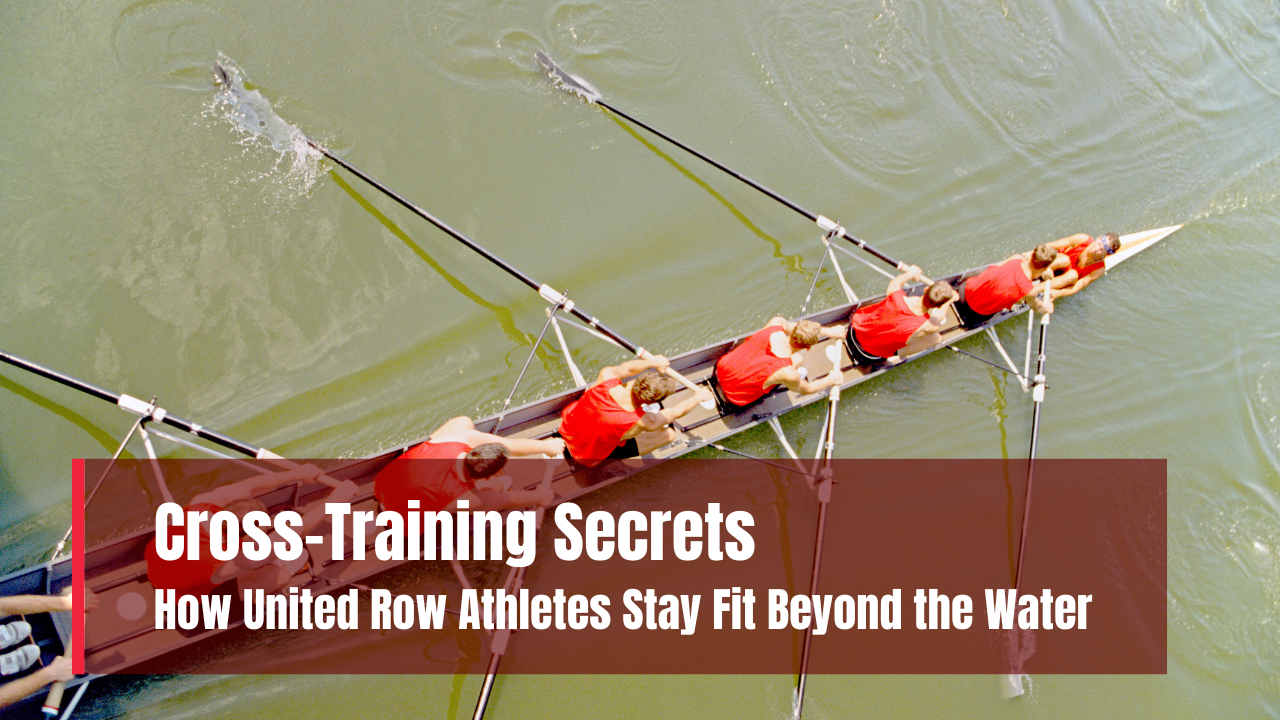The Power of Cross-Training in Rowing: Cross-training is the not-so-hidden advantage that keeps United Row athletes performing at their peak—even when they’re nowhere near the water. While many assume rowing success comes solely from endless hours of water practice, the reality is far more complex. Behind every explosive stroke and every powerful sprint lies a well-rounded training regimen built on diversity, strategy, and smart planning.
This article reveals the real fitness formula behind United Row’s consistent athletic edge. We’ll dive into the specific workouts they use, why those workouts matter, and how cross-training plays a vital role in keeping their athletes strong, balanced, and healthy. Whether you’re an aspiring rower or a seasoned coach, this guide will offer practical insights into building a complete, water-ready body through versatile training.
The Power of Cross-Training in Rowing
At its core, cross-training is about developing a more complete athlete by training outside of one’s primary sport. For rowers, this means incorporating off-water exercises that target strength, endurance, flexibility, and recovery. United Row athletes integrate swimming, cycling, strength training, yoga, and even hiking into their routines—not as a break from rowing, but as an essential component of their rowing training strategy. These sessions boost cardiovascular health, improve muscle symmetry, and extend athletic longevity, making cross-training a key factor in both peak performance and injury prevention.
Overview: United Row’s Weekly Cross-Training Elements
| Day | Cross-Training Activity | Focus Area |
| Monday | Strength Training + Core | Muscle power, stability |
| Tuesday | Rowing + Indoor Cycling | Endurance, leg strength |
| Wednesday | Yoga + Mobility Work | Flexibility, recovery |
| Thursday | Rowing + Weight Training | Speed, explosive power |
| Friday | Swimming | Full-body cardio, breath control |
| Saturday | Trail Running or Hiking | Cardiovascular fitness, leg endurance |
| Sunday | Active Recovery | Muscle repair, light movement |
Why Cross-Training Matters for Rowers
Cross-training isn’t just a supplement—it’s a strategic necessity for serious rowers. United Row understands that rowing relies heavily on repetitive motion, which can easily lead to muscular imbalances and overuse injuries if not countered with variety. By blending in different types of movement, rowers give overworked muscles time to heal while still pushing overall fitness forward.
This variety strengthens supporting muscle groups, increases joint flexibility, and boosts cardiovascular endurance. Even more, it helps rowers train during times when rowing isn’t feasible, such as during bad weather or in the off-season. That continuity is crucial in preserving progress and avoiding setbacks. In essence, cross-training fills the physical and mental gaps that rowing alone cannot.
Key Cross-Training Exercises Used by United Row Athletes
United Row integrates a range of off-water workouts designed to support rowing-specific goals without wearing out the same muscle groups. Here’s a breakdown of the most essential ones:
1. Indoor Cycling
A low-impact yet high-output cardio session, indoor cycling mirrors the demands of rowing in terms of leg engagement and endurance. It’s a go-to for building stamina and strengthening the lower body without stressing joints.
2. Swimming
Swimming is a full-body, low-resistance exercise that enhances lung capacity, improves recovery, and builds shoulder and core strength. The water also supports body weight, allowing rowers to train without joint strain.
3. Weight Training
Weight training is essential for building raw power. Exercises like squats, deadlifts, and pull-ups target muscles used in rowing strokes—especially the glutes, quads, lats, and core. United Row athletes follow periodized strength plans to ensure gains translate into water performance.
4. Running
Running, particularly trail or hill running, offers both endurance and agility benefits. Short sprints improve anaerobic capacity, while longer runs develop aerobic base, helping athletes withstand high race intensities.
5. Yoga and Mobility Work
Yoga enhances body awareness, flexibility, and balance—all important for stroke efficiency and injury reduction. Mobility work, such as foam rolling or dynamic stretching, ensures joints stay limber and movement remains smooth.
Benefits of Cross-Training for Rowers
What makes cross-training such a cornerstone of United Row’s program is how directly it impacts rowing success. Here’s what athletes gain from their multi-sport approach:
- Injury Prevention: Avoids overuse injuries by spreading physical stress across multiple muscle groups and movement patterns.
- Muscle Balance: Strengthens supporting muscles often neglected in rowing, reducing imbalances.
- Endurance Improvement: Cardio variety builds heart and lung strength, boosting stamina.
- Strength Development: Resistance training leads to more powerful and efficient strokes.
- Mental Refreshment: Keeps training exciting, helping athletes avoid burnout.
- Year-Round Fitness: Maintains conditioning when rowing outdoors isn’t possible.
Weekly Cross-Training Plan Sample
Below is a weekly training structure modeled on United Row’s routines, ideal for rowers in training blocks or the off-season:
Monday: Full-body strength training focused on compound lifts, followed by core circuits
Tuesday: On-water rowing intervals paired with 30 minutes of indoor cycling
Wednesday: Restorative yoga session + targeted mobility drills
Thursday: Power-focused rowing pieces + upper-body strength work
Friday: Long swim session (endurance pacing with breath control drills)
Saturday: 60-minute trail run or hill repeats for leg stamina
Sunday: Active recovery (light yoga, stretching, or easy walk)
Two Must-Have Cross-Training Habits
- Track Your Progress: Recording workouts, fatigue levels, and improvements ensures smarter adjustments over time. A training journal is a powerful tool in maximizing the impact of your cross-training routine.
- Never Skip Warm-Up or Cool Down: Prepping the body properly before and after a workout improves recovery and reduces injury risk. Even five minutes of movement and stretching can make a noticeable difference.
What Coaches Say About Cross-Training
Top coaches at United Row emphasize that cross-training is not a substitute for rowing but a foundation for sustainable excellence. According to them, athletes who commit to diversified training are more responsive to on-water coaching and recover faster from intense sessions. Coaches also note that their best rowers are often their best cross-trainers—because they understand the value of full-body conditioning and smart recovery.
FAQs
1. Why is cross-training important for rowers?
2. What are some good cross-training exercises for rowing?
3. Can cross-training improve rowing endurance?
4. How often should rowers cross-train?
5. Is cross-training useful in the off-season?
Final Thought
Cross-training isn’t a trend—it’s a training philosophy that United Row lives by. By stepping off the boat and into the gym, pool, or yoga mat, their athletes build the physical depth and mental resilience needed to excel when it counts. The variety not only keeps their bodies stronger but also keeps the sport enjoyable and sustainable.
If you’re serious about leveling up your rowing performance, now’s the time to rethink your routine. Don’t just row—train like a complete athlete. Feel free to share your experiences, ask a question, or explore more performance insights. Your next personal best might start with your next off-water workout.












